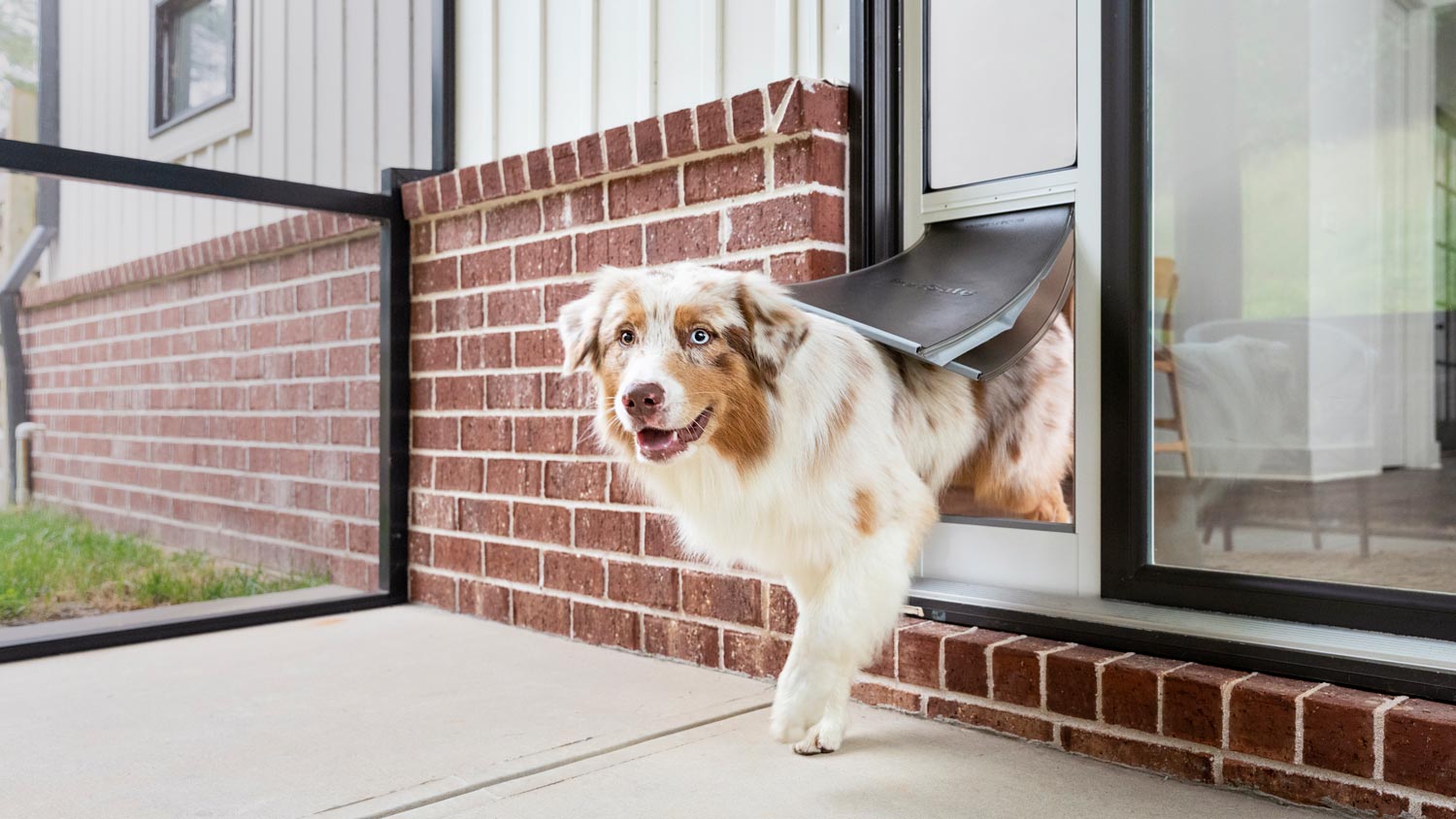7 Types of Dog Doors and How to Pick the Right One
So Fido can come and go in style


A doggy door opens up your pet to a world of freedom, and gets you off the hook when it comes to letting them in and out of your home. But with so many dog door options, it’s hard to know the difference (let alone choose) between them. Read on to find out what makes each unique, and which might be the best option for you and your pet.
What to Consider When Choosing the Best Dog Door
You might be ready to install your dog door so you can say hello to freedom and goodbye to opening the door for your pup to potty. But that doesn’t mean any type will work for you and your dog. Before getting into the specific types of doggy doors, here are some factors and features to consider.
Size
Start by measuring your dog, cat, bunny, or guinea pig (you get the idea—whichever of your animal friends will use the door). Measure your pet from the top of its shoulders to the ground. Then, measure between the two widest points from shoulder to shoulder. Do not measure above the head. Pets tend to bend and crouch to enter small spaces. If you have two pets, take measurements of the largest one. You can ask a local handyperson to help you find the right size.
Living Arrangements
Your living arrangements are key in determining what type of dog door you’ll get. Some types are permanent solutions that require cutting into an existing wall or door structure. If you rent or own your home, you might be more interested in (or required to get) a temporary solution.
Safety
A doggy door is sometimes an invitation for would-be burglars, insects, and wild animals. Never mount a pet door near door knobs or levers. Pet doors in the rear of the house are hidden from neighbors and, therefore, may be vulnerable to people with nefarious intentions. Address the security risk of pet doors before, during, and after installing a pet door. For added safety, consult a home security expert in your area.
Also, remember your other little friends—kids! Consider any small children who may be tempted to crawl through the pet door. A garage door may seem like an ideal place for a pet door, but you should avoid dog doors on your garage door to keep your kiddos safe from harm.
Flaps
Most doggy doors come with flaps. A good flap works for your furry friend while keeping unwelcome critters and natural elements out. Flaps come in single-flaps made of plastic to heavy-duty double and triple vinyl flaps that withstand 50 mph winds. The dual flaps help with insulation and shield the home’s interior from dirt, rain, or snow. However, sometimes, it takes dogs a little more time to get used to navigating two or more flaps. Plus, flaps start deteriorating over time.
Noise
Some pet doors make more noise than others. For example, doors that produce a loud clapping sound can startle some dogs. Even some automated doggy doors can produce sounds you and your pet find annoying. If you’re concerned about the possibility of noise, ask your pro about it.

1. Door-Mounted Pet Doors
The traditional door-mounted rectangular open with flap is what most people imagine at the mention of a doggy door. However, door-mounted pet doors come in different sizes and are made with various materials. Door-mounted doggy doors are easy for your pet to use and are also simple to install, depending on your DIY skills. You can create a hole in the center of a solid flat door or cut out a panel on a door with multiple panels.
Pros
DIY-friendly
Less expensive than other dog door options
Available in various sizes and materials
Doesn’t require changes to your home
Cons
Can potentially be a security threat, common in doors for larger dogs
You’re limited to where you can install a dog door in your home
May not be aesthetically pleasing
Models with little-to-no insulation can lead to energy loss and inconsistent indoor temperature
Best For: Pet owners who need a budget-friendly door for small pups.
2. Wall-Mounted Doggy Doors
Wall-mounted pet doors are installed in an exterior wall and work for those who would rather incorporate the pet door into the home’s exterior siding, stucco, or brick finish. It’s also ideal if you have a fenced area located on the side of the house where there is no exit. Because you are dealing with the home’s structure, including pipes and wiring, you’ll need a pro to install your dog door.
Pros
Protects your home from door entry security risks
More flexibility on where you want to install it
Works on siding, stucco, and brick exteriors
Provides insulation
Cons
Not DIY-friendly
More pricey than a door-mounted unit
Permanent solution
Best For: Pet owners who want a more secure, energy-efficient door for any dog size.
3. Sliding Pet Doors

Many homes have sliding doors that lead to a patio, backyard, or deck. Of course, you won’t put a pet door in a sliding door. However, there are pet doors designed to work with sliding door systems. These doggy doors fit into existing sliding-glass door frames, are inexpensive, and are easy to install. Sliding glass pet doors are available in different colors and finishes, and they take less than an hour to install.
Pros
DIY-friendly installation
Doesn’t require cutting into your wall or door
Can be removed easily
Available in various colors and finishes
Blends into your home’s aesthetics
Cons
Not the most budget-friendly dog door
Poses a security threat
Can be inconvenient for people using the sliding door
May not have an airtight seal
Best For: Pet owners who want a temporary solution (like renters) for small- to medium-sized pups.
4. Custom-Made Doggy Doors
A custom-made pet door allows you to address pet size, your home’s interior or exterior design, and safety concerns. You may opt for custom-made doggy doors if your pet is overweight or has a disability. By hiring someone who can custom-build, you can use whatever dimensions or specifications you wish. This allows you to seamlessly incorporate a pet door into the home’s decor, such as a doggy door hidden behind a kitchen cabinet door.
Pros
Let’s you create a door that caters to you and your dog’s needs
Can fit into your home’s aesthetics
Provides the most security against theft and critters
Comes in various styles and materials
Cons
High upfront cost
Permanent solution
Best For: Pet owners who need a dog door with features that cater to their specific circumstances for any sized dog.
5. Smart Pet Doors

Like with anything home-related, there are high-tech doggy door options. This includes a door that can be operated from a SmartPhone app. Some companies, like PetSafe, make microchip pet doors that read a microchip embedded in your pet and open automatically when your pet approaches. Some smart doggy doors slide open, elevator-style, so your pup can pop in without flipping a flap. Smart doggy doors cost more. You can get video monitoring in some systems that cost over $2,000. More quiet automated doors may work better for smaller dogs who spook easily.
Pros
Conveniently control when your dog uses the door
Know what or who’s trying to get in (or out of) your home
More energy-efficient than other types
Cons
Pricey initial cost
Requires an energy source that may not be available all the time
Not a DIY-friendly project
Best For: Pet owners who want the added convenience of a smart doggy door in areas with a reliable energy source.
6. French Door Pet Door
French doors are common in traditional architecture, leading to a porch or the backyard. You can preserve the French door decor with a doggy door designed to fit into one of the glass panels. These doors have clear trips and flaps to replicate the design of a French door.
Pros
Seamlessly fits into your home’s existing style
Comes in multiple colors and sizes
Isn’t an invasive solution
Designed for installation needs
Comes with secure locking covers for additional safety measures
Cons
Not easy to install
More costly than others
Best For: Pet owners who have a French door, don’t want to alter the structure of their home, and need a unit that prioritizes energy efficiency and security.
7. Bump-Out Doggy Doors
A doggy door bump-out can be added to the back or side of the house. Consider a bump-out pet door a mini home addition. The doggy door bump-out creates a barrier between the home and the outside. The bump-out can be 2 feet by 4 feet. The key is to make it large enough for the pet to turn around but still little enough so that it’s kid-proof. You can finish the bump-out with siding, brick, or stucco to match your home’s exterior.
Pros
Fits your home’s needs
Can be created to fit your dog’s size
Offers more insulation and protection from outdoor weather compared to traditional doggy doors
Protects from security threats
Cons
Pricey
Complicated installation that may need multiple dog doors
May not fit your home’s layout
Larger bump-out doors may pose a security threat
Best For: Pet owners who’d like a more customized dog door regardless of their dog’s size.





- Power Washing
- Greenhouse Companies
- Wood & Pellet Stove Repair
- Vinyl Siding Repair Contractors
- TV Antenna Services
- Ceiling Repair Companies
- Wall Repair Services
- Emergency Handymen
- Countertop Repair
- Vinyl Siding Cleaning
- Furniture Assembly
- Trampoline Assembly
- Carport Repair
- TV Mounting
- Chain Link Fence Repair
- Picture Hangers
- Electrical Handymen
- Handymen Plumbers
- Mailbox Installation
- Treehouse Builders
- Door Refinishing
- Aquarium Services
- Grab Bar Installation
- Caulking Services
- Grill Assembly
- Pet Door Safety Tips to Keep Your Doggy Doors Safe
- Who Installs Doggie Doors?
- Standard Door Sizes for Interior and Exterior Doors
- 23 Types of Doors for Inside and Outside Your Home
- 7 Types of Interior Doors to Use in Your Home
- 4 Types of Storm Doors and How to Choose the Best One
- How Long Do Front Doors Last?
- 5 Ways To Make Your Front Door Energy Efficient
- 10 Unique Ideas for Interior Door Designs
- How to Insulate a Door















